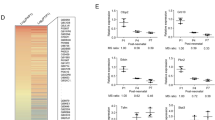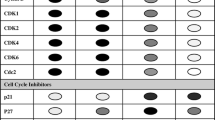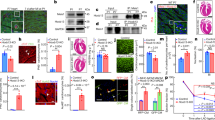Abstract
Cardiac myocytes proliferate most rapidly during the hyperplastic phase of heart development; however, the level of cell cycle activity is drastically down regulated after birth. Further growth of the heart is achieved by hypertrophic growth of cardiac myocytes. The mechanism that controls the switch from hyperplastic proliferation to hypertrophic growth in cardiac myocytes is unknown. Understanding this fundamental mechanism of cardiac myocyte biology would be most beneficial for studies directed towards myocardial regeneration. In this study, we identified changes in the expression of proteins involved in cell cycle regulation during the hyperplastic to hypertrophic transition of cardiac myocytes. Using a high-throughput immunoblotting technique, we examined 200+ proteins in primary cultures of cardiac myocytes at different developmental time points to determine the important regulators of this transition. In addition, we also analyzed samples from an immortalized cardiac myocyte cell line to compare expression levels of cell cycle regulatory proteins to our primary cultures. Our findings by this uncovered proteomic screen identified several potential key regulatory proteins and provide insight into the important components of cardiac myocyte cell cycle regulation.

Similar content being viewed by others
References
Soonpaa MH, Field LJ (1998) Survey of studies examining mammalian cardiomyocyte DNA synthesis. Circ Res 83:15–26
Pasumarthi KBS, Field LJ (2002) Cardiomyhocyte cell cycle regulation. Circ Res 90:1044–1054
Field LJ (2004) Modulation of the cardiomyocyte cell cycle in genetically altered animals. Ann NY Acad Sci 1015:160–170
Armstrong MT, Lee DY, Armstrong PB (2000) Regulation of proliferation of the fetal myocardium. Dev Dyn 219:226–236
MacLellan RW, Schneider MD (2000) Genetic dissection of cardiac growth control pathways. Ann Rev Phys 62:289–319
Lorenz P, Ruschpler P, Koczan D, Stiel P, Thiesen HJ (2003) From transcriptome to proteome: differentially expressed proteins identified in synovial tissue of patients suffering from rheumatoid arthritis and osteoarthritis by an initial screen with a panel of 791 antibodies. Proteomics 3:991–1002
Malakhov MP, Kim KI, Malakhova OA, Jacobs BS, Borden EC, Zhang DE (2003) High-throughput immunoclotting: ubiquitin-like protein ISG15 modifies key regulators of signal transduction. J Biol Chem 278:16608–16613
Claycomb WC, Lanson NA, Stallworth BS, Egeland DB, Delcarpio JB, Bahinski A, Izzo NJ (1998) HL-1 cells: a cardiac muscle cell line that contracts and retains phenotypic characteristics of the adult cardiomyocyte. Proc Natl Acad Sci USA 95:2979–2984
White SM, Constantin PE, Claycomb WC (2004) Cardiac physiology at the celluar level: use of cultured HL-1 cardiomyocytes for studies of cardiac muscle cell structure and function. Am J Physiol Heart Circ Physiol 286: H823–H829
Beltzner CC, Pollard TD (2004) Identification of functionally important residues of Arp2/3 complex by analysis of homology models from diverse species. J Mol Biol 336:551–565
Tsujimoto Y, Tomita Y, Hoshida Y, Kono T, Oka T, Yamamoto S, Nonomura N, Okuyama A, Aozasa K (2004) Elevated expression of valosin-containing protein (p97) is associated with poor prognosis of prostate cancer. Clin Cancer Res 10:3007–3012
Kubista M, Rosner M, Miloloza A, Hofer K, Prusa AR, Kroiss R, Marton E, Hengstschlager M (2002) BRCA1 and differentiation. Mutat Res 512:165–172
Soonpaa MH, Koh GY, Pajak L, Jing S, Wang H, Franklin MT, Kim KK, Field LJ (1997) Cyclin D1 overexpression promotes cardiomyocyte DNA synthesis and multinucleation in transgenic mice. J Clin Invest 99:2644–2654
Busk PK, Bartkova J, Strom CC, Wulf-Andersen L, Hinrichsen R, Christoffersen TE, Latella L, Bartek J, Haunso S, Sheikh SP (2002) Involvement of cyclin D activity in left ventricle hypertrophy in vivo and in vitro. Cardiovasc Res 56:64–75
Falvella FS, Menegola E, Giavini E, Ottey M, Fidanza V, Croce CM, Hueber K, Dragani TA (2000) Expression of FHIT protein during mouse development. Anat Rec 260:208–211
Mohler PJ, Woohyum Y, Bennett V (2004) Ankyrin-B targets beta-2 spectrin to an intracellular compartment in neonatal cardiomyocytes. J Biol Chem 279:40185–40193
Townsend PA, Scarabelli TM, Davidson SM, Knight RA, Latchman DS, Stephanou A (2004) STAT-1 interacts with p53 to enhance DNA damage-induced apoptosis. J Biol Chem 279:5811–5820
Stephanou A, Scarabelli TM, Townsend PA, Bell R, Yellon D, Knight RA, Latchman DS (2002) The carboxyl-terminal activation domain of the STAT-1 transcription factor enhances ischemia/reperfusion-induced apoptosis in cardiac myocytes. FASEB J 16:1841–1843
Walsh K, Perlman H (1997) Cell cycle exit upon myogenic differentiation. Curr Opin Genet Dev 7:597–602
Lanson NA, Egeland DB, Royals BA, Claycomb WC (2000) The MRE11-NBS1-RAD50 pathway is perturbed in SV40 large T antigen-immortalized AT-1, AT-2, and HL-1 cardiomyocytes. Nucleic Acids Res 28:2882–2892
Heidkamp MC, Scully BT, Vijayan K, Engman SJ, Szotek EL, Samarel AM (2005) PYK2 regulates SERCA2 gene expression in neonatal rat ventricular myocytes. Am J Physiol Cell Physiol. 289:C471–C482
Hirotani S, Higuchi Y, Nishida K, Nakayama H, Yamaguchi O, Hikoso S, Takeda T, Kashiwase K, Watanabe T, Asahi M, Taniike M, Tsujimoto I, Matsumura Y, Sasaki T, Hori M, Otsu K (2004) Ca(2+)-sensitive tyrosine kinase Pyk2/CAK beta-dependent signaling is essential for G-protein-coupled receptor agonist-induced hypertrophy. J Mol Cell Cardiol 36:799–807
Melendez J, Welch S, Schaefer E, Moravec CS, Avraham S, Avraham H, Sussman MA (2002) Activation of pyk2/related focal adhesion tyrosine kinase and focal adhesion kinase in cardiac remodeling. J Biol Chem 277:45203–45210
Dowell JD, Field LJ, Pasumarthi KBS (2003) Cell cycle regulation to repair the infarcted myocardium. Heart Fail Rev 8:293–303
Author information
Authors and Affiliations
Corresponding author
Rights and permissions
About this article
Cite this article
Evans, H.J., Goodwin, R.L. Western array analysis of cell cycle protein changes during the hyperplastic to hypertrophic transition in heart development. Mol Cell Biochem 303, 189–199 (2007). https://doi.org/10.1007/s11010-007-9473-y
Received:
Accepted:
Published:
Issue Date:
DOI: https://doi.org/10.1007/s11010-007-9473-y




